| Hartington Hall | |
| |
Hartington Hall is a much altered and extended 17th century manor house at Hartington, Derbyshire. It is now a Youth Hostel Association (YHA) youth hostel.
The
hall was built by the bateman family who were a well established
Norfolk family who settled in Hartington in the 16th century. Richard
Bateman married Ellen Toplis of Tissington and it was their eldest son,
Hugh, who built the new manor house at Hartington in 1611. In 1862 Thomas Osborne Bateman oversaw the substantial alteration and | 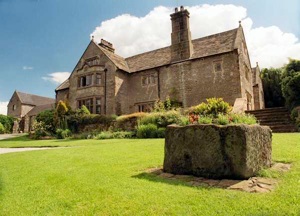 |
extension. The work was carried out by Henry Issac Stevens of Derby.
The
house is built to a 'H' plan; the main entrance frontage has three
storeys and three gabled bays. The central bay recessed with an
off centre porch entrance. The dates of building and alterations are
recorded on a lintel above the door. Today the buidling carries Grade
II Listed status.
The house is the oldest, continually operating
Youth Hostel in the Peak District and is the flagship hostel of the
YHA. In recent years the property has undergone a £1.3million
refurbishment programme. | 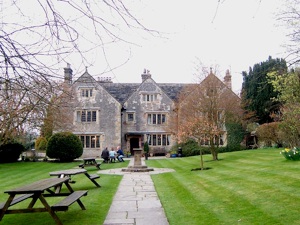 |
| |
Highlow Hall
| |
| |
The
hall is a modest but wholly delightful and important manor house,
probably of the late 16th century. The hall is set in the
breathtaking countryside above Hathersage.
The house it
irregular with a bold canted bay to the left of the southern frontage
with a recessed bay to the right of it, breaking forward slightly.
To the right the property ends with a remarkably plain, straight
gable. | 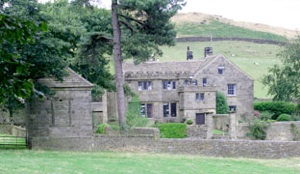 |
| |
| Stanton Hall | |
| |
Stanton
Hall is a privately owned country house at Stanton-in-Peak in the
Derbyshire Peak District. It is currently the home of the
Davie-Thornhill family. The hall carries Grade II Listed status.
The
manor of Stanton was owned for two centuries by the Bache family, but
passed to the Thornhill family by the 1696 marriage of Mary Pegge,
heiress of the estate, to John Thornhill or Thornhill. The
Thornhill family and their direct descendants are still in residence.
The House has three principal building phases. | 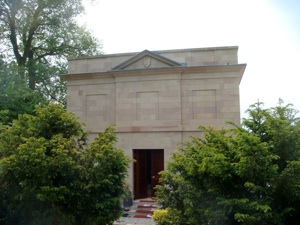 |
| The Oldest part dates from the replacement ofthe
medieval manor house in 1963. Only one single gabled bay at the
north of the house now remains of this period. In the 17th
century, the 1963 house was largely replaced with a two-storey mansion
with a seven bayed east frontage. In 1799/1800, Bache Thornhill
(High Sheriff of Derbyshire in 1776) added a substantial southern
facing extension, doubling the size of the house. The new, two
storey, five by five bay addition was designed in a Palladian style by
architect Lindley of Doncaster. The entrance front to the south
has the three central bays projecting, with a semicircular Doric porch | 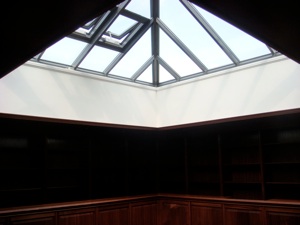 |
with balcony over, all covered by a pediment.
Bache Thornhill also created a deer park and ornamental gardens on the estate.
Oldfield Design Ltd were commissioned to carry out alterations to the hall, including work on a William Morris decorated room.
More
recently Oldfield Design returned to design a detached library building
(pictured) which was erected within the ground of the hall during 2004
and 2005.
|  |
| |
| Holme Hall | |
| |
Holme
Hall lies across the River Wye from Bakewell town centre and was listen
in the Doomsday Book in 1086 as 'an outlier of the Kings manor of
Bakewell'.
The west frontage facing the river was formerly the
entrance and is of three bays and two and a half storeys with a
projecting porch, not blocked up and adapted. This, and the
dressings elsewhere, are made up of Millstone Grit Sandstone. |  |
The south frontage is of four bays, being part ofthe
main 1626 building which is constructed of roughly squared
Carboniferous Limestone with Millstone Grit Sandstone dressings
including quoins. Here there are three full storeys containing
the state rooms of the property.
The north-west range is in a
similar form to the south, but more plain and joins at right angles a
three-bay, two-storey range with two-light
| |
mullioned windows which may, in origin, be earlier than the main part of the house, but perhaps re-built by Robert Eyre in 1658.
Holme Hall has recently undergone a complete internal refurbishment, incorporating 21st century technologies.
Oldfield Design Ltd has conducted survey work on the existing building. | 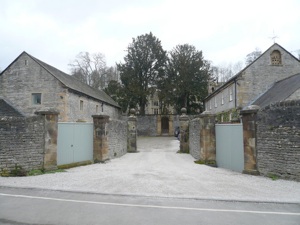 |
| |
| Winster Hall | |
| |
Winster Hall, built by Francis Moore in 1628, is the more important house on the north side of the main street.
The
Moore family rose from yeoman status in the 17th century to that of
gentleman by about 1720, when they rebuilt the hall. It became an
inn in the 1970s but has now reverted to being a private dwelling.
The
hall has three-storeys, with all the trappings; rusticated quoins and a
cornice topped by a parapet, complete with balustrade. The
windows are sliding sashes set in stone | 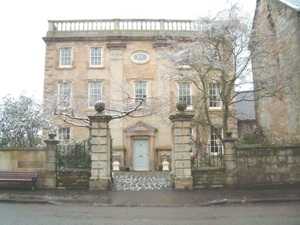 |
frames
with keystones and there is a roundel in the centre frontage and a good
doorway with columns either side, surmounted by an entablature.
The
hall stand back from the main street behind a sturdy pair of gate
piers. Gritstone, for the construction of the hall, was brought
by pack-horses from the Stancliffe Quarries in nearby Darley Dale.
Oldfield Design Ltd were employed to assist with alterations to the existing boundary wall. | 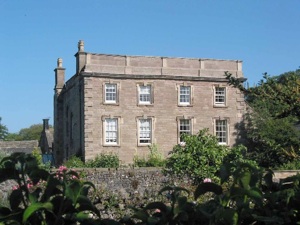 |
| |
| Harthill Hall | |
| |
Harthill
Hall is a Grade II Listed building situated in Alport near the town of
Bakewell. At some point during the early 15th century the house
was rebuilt in stone, probably around a courtyard.
Around
1599
the house was sold to the Manners family and from this date it was
reduced to a tenanted farm, being rebuilt accordingly. Hence it
is irregular, of early 17th century date, with straight gables and
originally had mullioned windows, of which one is also transomed.
Others have been replaced by sashes.
There is a good 16th century barn which may | 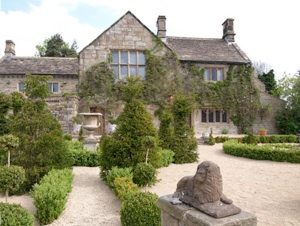 |
well
have been adapted out of part of the original house and another barn
which is thought to have been used as a chapel around 1259.
It
seems the house remained in the Haddon Estate until the 20th century
when it was sold. The outbuildings at Harthill Hall have
undergone major restoration into holiday apartments.
Oldfield Design Ltd undertook the work of converting the Listed outbuildings into a holiday complex. |  |
| |
| Ilam Hall | |
| |
A
Tudor mansion once stood on the site of Ilam Hall, the home of the Port
family. It was sold to David Watts Pike in 1809 and remodelled by
Jesse Watts Russell in 1821, the architect being one John Shaw.
In 1875, Jesse Watts Russell died and the house passed to the
Hanbury family, who sold it in 1927 to a restaurateur. When he
went bankrupt, the building was sold to a domolition contractor, who
promptly moved in and took down two thirds of the building.
Ilam Hall and popular country park belong to | 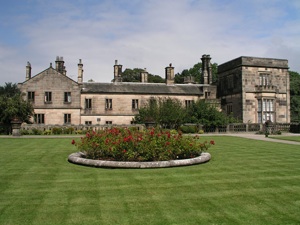 |
the
National Trust now and the hall and grounds are used as a Youth Hostel,
tearooms, shop, information centre, car park and toilets. What is
left of the hall is still an imposing and stately structure, and in the
gardens and parkland there is much to see.
Oldfield Design Ltd
carried out a 'quinquennial survey' for the YHA, and a sewage treatment
plant for the YHA & National Trust which included an extensive
archaeological study and excavation. | 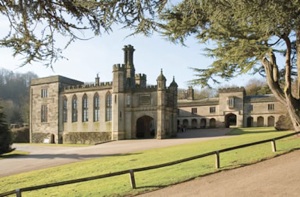 |
| |
| Work on other Listed Buildings: | |
| |
-The Grange, Ashford-in-the-Water
Various refurbishment work, alterations, survey work and conversions. | |
| |
-The Old Parsonage, Taddington
New vehicular access, conversion of outbuildings to ancillary use. | |
| |
-Smalldale Old Hall, Smalldale
Alteration and conversion of barn to ancillary accommodation | |
| | |


